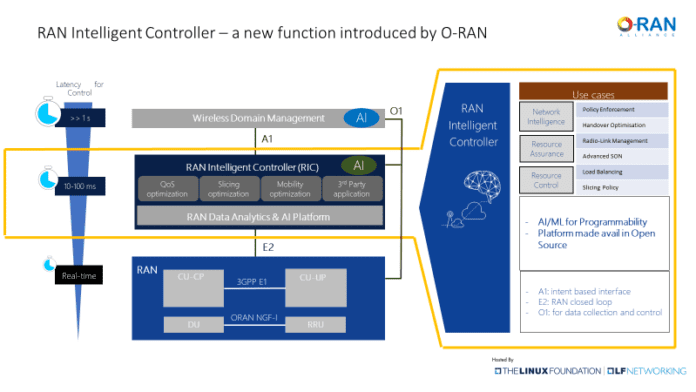Like most things telecom, Open RAN brings with it a complex alphabet soup of acronyms and initialisms. Here we’re providing brief explanations of some key terminology. And, to be sure, this is a superficial description of the following terms and a fraction of the full set of relevant jargon.
Functional split
The notion of functional splits in the RAN first came up in 3GPP Release 14 and was further defined in Release 15. The high-level idea is that the primary 5G use cases–enhanced mobile broadband (eMBB), ultra reliable low latency communications (URLLC), and massive internet of things–require a highly flexible RAN architecture marked by a, well, split of control and user plane gNodeB functions to enable a more feature rich, responsive network that can adapt to support a wide variety of use cases and deployment configurations.
The specific components, delineated below, require open interfaces between remote radios units and a virtualized baseband unit, which can be further subdivided into a central unit and a distributed unit. That idea of subdividing functionality, in terms of either physical location, type of workload or both, is core to Open RAN and, more broadly, 5G. And if different vendors provide different pieces, there has to be an interoperability framework.
Central unit
The central unit, or CU, supports non-real time Layer 2 and Layer 3 workloads like RRC and PDCP.. In the context of Open RAN, this is software hosted on a server that can be located in an edge datacenter, cell site, central office, regional datacenter, or even co-located with the distributed unit. A CU can support multiple distributed units connected via midhaul.
Distributed unit
The distributed unit, DU, handles real-time L1 and L2 scheduling, baseband and RF processing, RLC, MAC and some PHY functions. Schematically the DU sites between the CU and the remote radio unit but, in both theory and practice, the DU server can be co-located with the CU, at a cell site, at an edge cloud site or in a central office.
Remote radio unit
The remote radio unit (RRU) includes the digital front end, some PHY layer functions, digital beamforming and other features associated with legacy cellular radios. RRUs come in a variety of form factors informed by manufacturer and site-specific deployment considerations.
Parallel Wireless VP of Marketing Eugina Jordan tied it all together: “The future evolution of RAN will be toward dynamic functional splits…The functionality of the RAN will be distributed between DUs and CUs as it is defined in 5G…In different scenarios, these elements can collapse together and create a single physical entity with different virtual functionalities.”
RAN Intelligent Controller
The RAN Intelligent Controller (RIC) is a software platform responsible for radio orchestration and management; it supports applications like mobility and interference management, network policies, admission control and so forth. In a vRAN, the RIC collects, analyzes and acts upon network data to optimize user experience using artificial intelligence and machine learning algorithms. The RIC comes in two flavors, near-real time and non-real time; the former runs xApps that pool data from all forms of radio infrastructure to continuously optimize user experience and network efficiency based on fluctuating demand and resource availability while the latter takes on things like configuration, device, fault, performance and lifecycle management.
In June Nokia and AT&T conducted a RIC trial on the carrier’s millimeter wave 5G network in New York City. Nokia’s Sandro Tavares, global head of mobile networks marketing, told RCR Wireless News the trial met its goals of improving spectral efficiency. Measurement and optimization xApps were used to collect live network data. In this case the partners used Measurement Campaign, Automated Neighbor Relation and Admission Control.
Describing the trial, Tavares said, “It was focused on one specific part of the city so not many sites. One thing that is important to learn from the architecture is that one RIC instance can support several base station sites. The way the architecture is evolving, and especially on 5G networks, you can have the RIC co-localized with the centralized until that basically handles that part of the baseband processing. Then, from that, you can actually manage up to hundreds of distributed units that are going to be deployed in a city.”
While the focus in this trial was on RAN optimization, Tavares said this premise could be extended and open up “new possibilities of third-party applications on top of the network. Basically any service that would benefit from having access to low latency could benefit from having a more direct connection to the RAN. For example, in just an anecdotal way, if you’re looking to a video streaming service or a video communication service, you can have an xApp that can optimize the delivery of the video to the terminals.”
For a comprehensive look at Open RAN, download this free report and register to attend the Open RAN Forum.


